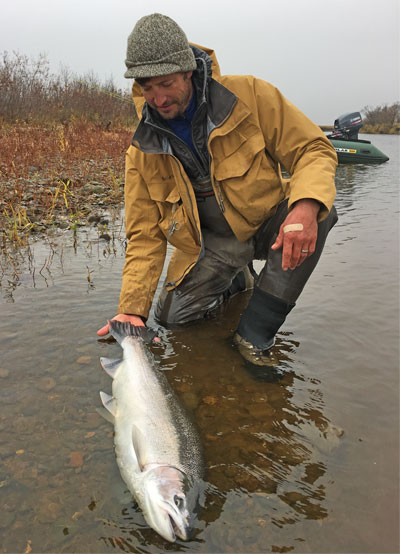Field Notes from a journey to Kamchatka’s steelhead strongholds.
By Dr. Matthew Sloat
Russia’s 800-mile long Kamchatka Peninsula contains a vast network of rivers that remain free-flowing from headwaters to ocean and are virtually unaltered by human development. The region produces up to one-fourth of all wild Pacific salmon and hosts the greatest diversity of salmonid species on Earth, including Asia’s only steelhead populations.
In the fall, I returned to this salmon paradise as a collaborating scientist in the Kamchatka Steelhead Project, an integrated conservation, angling, and science program co-directed by the Conservation Angler, Moscow State University, and the Russian Academy of Sciences. Since its inception in 1994, the Kamchatka Steelhead Project has been advancing the conservation of Kamchatka steelhead rivers and contributing critical new knowledge about the ecology and evolution of steelhead in rivers under minimal human influence.

Leaving the village of Esso via Mi-8 transport helicopter, we flew to field camps on the Utkholok and Kvachina rivers, priority watersheds for Wild Salmon Center and our conservation partners as we work to grow the network of protected salmon strongholds in Kamchatka and the wider Russian Far East. On board, our crew included an international team of scientists, anglers, outfitters and guides. We cleared mountain passes and I watched foothills give way to a vast tundra plain veined by a web of salmon rivers flowing west to the Sea of Okhotsk.
A long arc of scientific discovery linked our journey with the past. The first scientific descriptions of Oncorhynchus mykiss, the Latin name for steelhead and rainbow trout, come from surveys of Kamchatka rivers by German naturalists Georg Steller and Johann Walbaum in the 1700s. But it wasn’t until 1975 that Russian scientists led by Dr. Ksenia Savvaitova made the first systematic study of Kamchatka steelhead populations. In 1994, Savvaitova returned to Kamchatka with Wild Salmon Center founder Pete Soverel marking the beginnings of the angler-sponsored Kamchatka Steelhead Project.

These pioneering efforts provide the foundation for continued steelhead science and conservation in Kamchatka. Our ongoing field work, new molecular genetic techniques, and a twenty year record of archived samples from angler caught steelhead are providing new information on the role of habitat, life history, and genetic diversity in sustaining steelhead population health.
There is still much to learn about these incredible fish. This year, with the help of angler sponsors, we collected field data not just from steelhead, the ocean-going form of O. mykiss, but also the variety of other life histories the species exhibits, such as estuary migrants, and resident rainbow trout that complete their entire life cycle within freshwater. The field season provided important samples that we will use over the coming months to answer questions about the genetic basis for the variety of life histories, the survival costs and benefits among life histories, and how each life strategy might respond to a changing environment.
These new discoveries will enrich our understanding of Kamchatka steelhead, but they will also provide key information to aid the recovery of depleted North American steelhead populations.
Dr. Sloat is science director at Wild Salmon Center.
